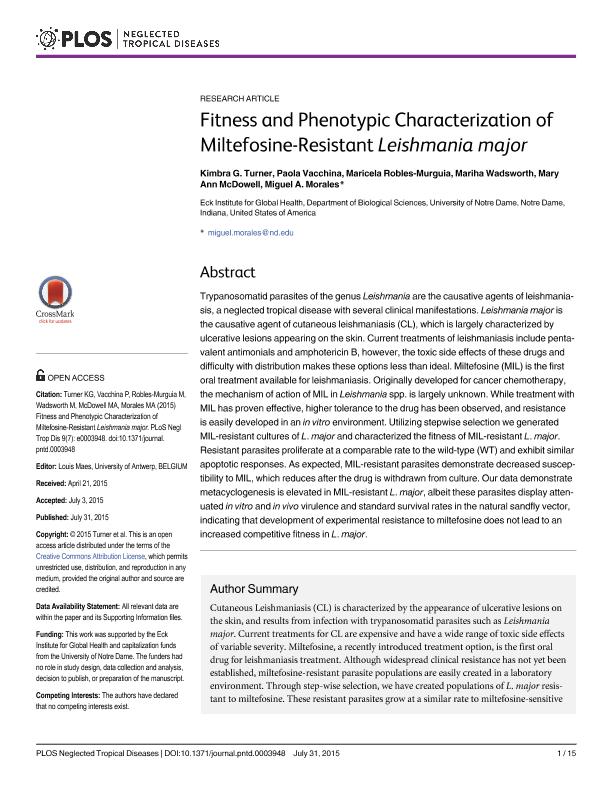Mostrar el registro sencillo del ítem
dc.contributor.author
Turner, Kimbra G.
dc.contributor.author
Vacchina, Paola

dc.contributor.author
Robles Murguia, Maricela
dc.contributor.author
Wadsworth, Mariha
dc.contributor.author
McDowell, Mary Ann
dc.contributor.author
Morales, Miguel A.
dc.date.available
2018-07-17T16:59:11Z
dc.date.issued
2015-07
dc.identifier.citation
Turner, Kimbra G.; Vacchina, Paola; Robles Murguia, Maricela; Wadsworth, Mariha; McDowell, Mary Ann; et al.; Fitness and phenotypic characterization of miltefosine-resistant Leishmania major; Public Library of Science; Neglected Tropical Diseases; 9; 7; 7-2015; 1-15; e0003948
dc.identifier.uri
http://hdl.handle.net/11336/52400
dc.description.abstract
Trypanosomatid parasites of the genus Leishmania are the causative agents of leishmaniasis, a neglected tropical disease with several clinical manifestations. Leishmania major is the causative agent of cutaneous leishmaniasis (CL), which is largely characterized by ulcerative lesions appearing on the skin. Current treatments of leishmaniasis include pentavalent antimonials and amphotericin B, however, the toxic side effects of these drugs and difficulty with distribution makes these options less than ideal. Miltefosine (MIL) is the first oral treatment available for leishmaniasis. Originally developed for cancer chemotherapy, the mechanism of action of MIL in Leishmania spp. is largely unknown. While treatment with MIL has proven effective, higher tolerance to the drug has been observed, and resistance is easily developed in an in vitro environment. Utilizing stepwise selection we generated MIL-resistant cultures of L. major and characterized the fitness of MIL-resistant L. major. Resistant parasites proliferate at a comparable rate to the wild-type (WT) and exhibit similar apoptotic responses. As expected, MIL-resistant parasites demonstrate decreased susceptibility to MIL, which reduces after the drug is withdrawn from culture. Our data demonstrate metacyclogenesis is elevated in MIL-resistant L. major, albeit these parasites display attenuated in vitro and in vivo virulence and standard survival rates in the natural sandfly vector, indicating that development of experimental resistance to miltefosine does not lead to an increased competitive fitness in L. major.
dc.format
application/pdf
dc.language.iso
eng
dc.publisher
Public Library of Science

dc.rights
info:eu-repo/semantics/openAccess
dc.rights.uri
https://creativecommons.org/licenses/by-nc-sa/2.5/ar/
dc.subject
Leishmania Major
dc.subject
Miltefosine Resistance
dc.subject
Parasite Fitness
dc.subject
Sand Flies
dc.subject.classification
Otras Ciencias Biológicas

dc.subject.classification
Ciencias Biológicas

dc.subject.classification
CIENCIAS NATURALES Y EXACTAS

dc.title
Fitness and phenotypic characterization of miltefosine-resistant Leishmania major
dc.type
info:eu-repo/semantics/article
dc.type
info:ar-repo/semantics/artículo
dc.type
info:eu-repo/semantics/publishedVersion
dc.date.updated
2018-07-17T13:55:34Z
dc.identifier.eissn
1935-2735
dc.journal.volume
9
dc.journal.number
7
dc.journal.pagination
1-15; e0003948
dc.journal.pais
Estados Unidos

dc.journal.ciudad
San Francisco
dc.description.fil
Fil: Turner, Kimbra G.. University of Notre Dame-Indiana; Estados Unidos
dc.description.fil
Fil: Vacchina, Paola. University of Notre Dame-Indiana; Estados Unidos. Consejo Nacional de Investigaciones Científicas y Técnicas; Argentina
dc.description.fil
Fil: Robles Murguia, Maricela. University of Notre Dame-Indiana; Estados Unidos
dc.description.fil
Fil: Wadsworth, Mariha. University of Notre Dame-Indiana; Estados Unidos
dc.description.fil
Fil: McDowell, Mary Ann. University of Notre Dame-Indiana; Estados Unidos
dc.description.fil
Fil: Morales, Miguel A.. University of Notre Dame-Indiana; Estados Unidos
dc.journal.title
Neglected Tropical Diseases

dc.relation.alternativeid
info:eu-repo/semantics/altIdentifier/doi/http://dx.doi.org/10.1371/journal.pntd.0003948
dc.relation.alternativeid
info:eu-repo/semantics/altIdentifier/url/http://journals.plos.org/plosntds/article?id=10.1371/journal.pntd.0003948
Archivos asociados
